-
Posts
5,134 -
Joined
-
Last visited
Content Type
Profiles
Forums
Store
Help Articles
Posts posted by Hiroyuki
-
-
When they sell it in the stores around here it is normally over 1,000 yen....
1,100 yen to be exact.
http://www.rakuten.co.jp/masunosusi/412021/422678/
The same goes for sasa dango. At souvenir shops, they are over 1,000 yen a pack (containing 10 pieces), but at local supermarkets here, they are about 680 (when on sale) to 780 yen.
-
I am already sick of kaki!! I have a couple rotting away in my kitchen as I type because no one wants anything to do with them anymore.....
but I prefer the amagaki ones...
Too bad. You can't make hoshi gaki (dried persimmons) from ama gaki... This site says you can make hoshi gaki from ama gaki, but you can't make good ones.
http://www.naranougi.jp/QA/184hoshigaki.htm
(Japanese only)
-
Oh, yes, I like it. In fact, I was thinking of posting about it after dinner.
I have a minor question: Which is correct, masu no sushi or masuzushi?
I did some google searches and found that masu no sushi seems to be a product name of Minamoto http://www.minamoto.co.jp/ . But I can never be sure. Suffice it to say that both masu no sushi and masuzushi are acceptable.
I think it's rather expensive like so many other ekiben. Don't you think so?
-
Why have eggs risen so little relative to other staples?
In a word, because of the modern chicken farming that has increased the production of eggs.
From here:
http://www2.ocn.ne.jp/~who/syoku/tamago.html
(Japanese only)
-
Mushroom nabe with salmon.
My son adores mushrooms; he likes studying them and gathering them. But what with the typhoons and what with the earthquake and subsequent aftershocks (which still continue), this has been a bad year for wild mushroom gathering. So, the other day, I suggested my son that we make mushroom nabe on Nabe Day. He jumped at the suggestion. Today, I bought six different kinds of mushrooms: Buna shimeji, maitake, shiitake, nameko, amandare (local name for nara take), and enoki.
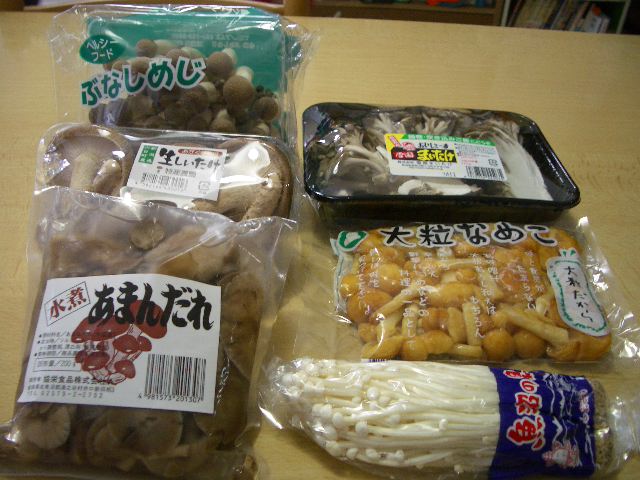
Other ingredients:
1/2 daikon
1/2 carrot
1/4 hakusai
1 pack tofu
200 g soumen (type of noodle)
3 slices of salmon
Miso
The pot overflowed because of too many ingredients!
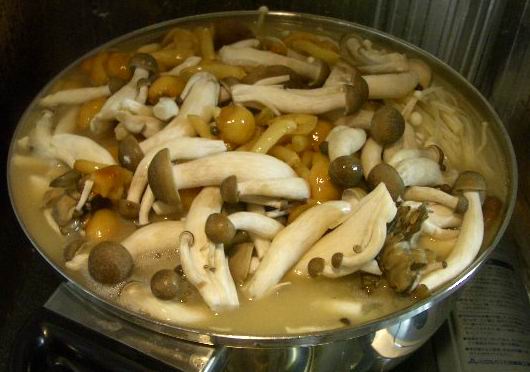
After dinner, we still had so much left.
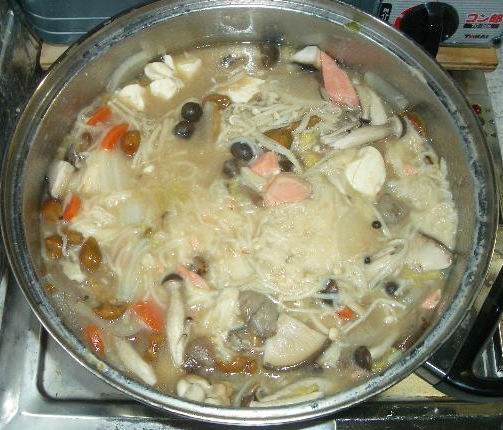
-
Fuyu gaki.
Which do you prefer, ama gaki like fuyu gaki or sawashi gaki (shibu gaki with their astringency removed)?
Have you ever had sawashi gaki?
Photo of fuyu gaki. Notice the big seed.
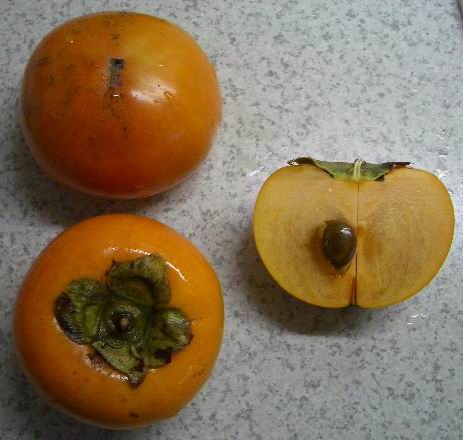
Edit to add:
If you haven't, you should! They are much sweeter and taste much better.
-
yuzu are quite small, about five to six cm (two inches or so) in diameter.
I underestimated the size of yuzu.
My parents, who live in Chiba prefecture, sent us a box full of fruit, vegetables, and other foods. Among them were seven yuzu, the smallest of which was 5.5 cm in diameter and the biggest 7.5 cm.
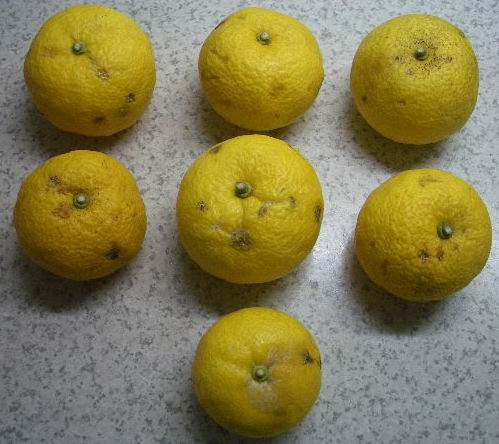
-
Wow, you got kuruma fu in your pot?! How did it come out?
-
What else could egui be used to describe?
The following are some of the results of a google search with egui:
Zuiki, kuwai, sansai (wild plant), spinach, shungiki, sato imo, yama imo, tochi no mi, gobo, soy milk, potato, sweet potato, coffee, cheese, hoya, tea, and melon (I'm not joking
 ).
).This site http://www.earthlanguage.org/dic/39.htm defines egui pretty well:
no English word for this taste ( Egui in Japanese): a kind of toxic taste like a green part of potato: it's not bitter, sour, hot or astringent, but perhaps your tongue wants to hang 'down' from your mouth.(えぐみ、えぐい)
Decent people like us (I'm joking
 ) should avoid the use of egui in everyday conversation altogether. Young people often use the word to mean ひどい (bad, terrible). For them, the word is quite similar to egetsunai in meaning. Refer to http://www.geocities.co.jp/Technopolis/4814/osaka/a.html. In fact, some of them seem to think that egui comes from egetsunai (which is totally false).
) should avoid the use of egui in everyday conversation altogether. Young people often use the word to mean ひどい (bad, terrible). For them, the word is quite similar to egetsunai in meaning. Refer to http://www.geocities.co.jp/Technopolis/4814/osaka/a.html. In fact, some of them seem to think that egui comes from egetsunai (which is totally false).Instead, we should use the noun egumi like this:
Egumi ga (or no) aru/nai/tsuyoi/ooi/sukunai えぐみが(or の)ある/ない/強い/多い/少ない
-
Takana zuke no abura itame (Takana pickles fried in oil).
Takana pickles are nothing new, but the takana pickles fried in oil I can get at one particular supermarket here in my town are really yummy. I almost always buy a pack when I go there.
-
Kinshi tamago.
I almost always make kinshi tamago when making 'gomoku zushi' and 'hiyashi chuuka'. My wife often makes iri tamago instead just because it's easier to make.

Those of you who don't know what kinshi tamago, visit the site:
http://www.coara.or.jp/~mieko/20020307sushi/0307sushi.htm
Again, I never add sugar to my kinshi tamago. Probably I am one of those few Japanese who hate sweetened tamago dishes. Fortunately, my wife and children don't like them, either.
-
I don't know how many of you are interested in learning Japanese, but this site contains a wide variety of links.
http://www.nmt.edu/~armiller/japanese/japanese.htm
Do you know of any other good sites?
-
i love puns like this!According to several sites, the reason for this is that 'touji' means both winter solstice (冬至) and hot spring cure (湯治).thank you for the links and photos...
Oh, do you? As a matter of fact, there seems to be another pun associated with it.
Yuzu is similar to yuuzuu (融通) in pronunciation. Yuuzuu has a number of meanings, one of which is 'flexible'.
The idea seems to be "take a yuzu hot bath to become healthy, and live a flexible life".
From here:
http://www.hana300.com/yuzu00.html
(Japanese only)
But I must tell you that I can never be sure if this is true.
-
Just a thought.
While reading this thread http://forums.egullet.org/index.php?showtopic=15704 , I was a little surprised that everyone described green tea as bitter. I know it is perfectly all right in English to use the term bitter to mean astringent, but in Japanese, we clearly distinguish between nigami (bitterness)/nigai (bitter) and shibumi (astringency)/shibui (astringent). Thus, ryoku cha (green tea) and kaki are described as shibui, while coffee and chocolate are described as nigai.
I found a table that you may find useful:
http://www.sf.airnet.ne.jp/~ts/japanese/me...2oEOn-E0Ny.html
-
安納こがね (I am not sure how to pronounce the kanji..
 )
) Found it. Annou あんのう.
-
I tasted low and high quality and the former is very bitter while the latter is amazing: round texture and sweet, vegetal flavor.
Great post and great photos, jogoode.
I couldn't agree with you more. This goes for sencha too. Sencha, especially gyokuro, can be astonishingly mild and sweet if properly made.
-
An update on the poison mushrooms.
http://mdn.mainichi.co.jp/news/20041105p2a00m0dm011000c.html
Seems this year's unpredictable weather has caused angel's wings mushrooms to grow funny. And more plentifully, which means people are eating more of them.
Thank you for the followup story, smallworld.
***
Do any of you remember that hon shimeji mushrooms are now cultivated?
http://www.yomiuri.co.jp/wine/news_g/20040208uj22.htm
(February 8, 2004, Yomiuri Shimbun)
The ones in the photo are sold only at Seibu Department Store at Ikebukuro, Tokyo. The article says that they are cultivated by Yamasa Shoyu, a food company. The company produces 300 to 500 kilograms of them annually.
And, this story is dated September 14, 2004.
http://www.business-i.jp/news/sou-page/new...-BIZCSKLZFA.nwc
It says that Takara Bio has started mass-producing hon shimeji mushrooms at a factory with an annual production capacity of 100 tons.
I live in such a small rural town and I have not yet seen any of those cultivated hon shimeji mushrooms sold at a supermarket.
My question is: Have any of you seen or actually eaten these cultivated ones? My son is curious to know.
-
according to folklore, is said to be a good colour for keeping spirits away". so when you take a bath with yuzu during winter solstice
Even today, it's quite customary to do that. I have never heard of that folklore, though. According to several sites, the reason for this is that 'touji' means both winter solstice (冬至) and hot spring cure (湯治). It's also quite customary to eat kabocha (squash) on the winter solstice.
Besides yuzu, sudachi and kabosu are also used for cooking purposes. They are harvested and shipped while they are still green.
http://www.bibisage.com/cooking/shokuzai/2003/0809/09_03.htm
First photo: Kabosu
Second: Sudachi
Kabosu are bigger (100-120 g in weight) than sudachi (25-30g) and are slightly bitter.
Recently, shiikuwaasaa (sp?), a specialty of Okinawa, have become very popular.
-
so the main q i have is, just how big are yuzu? i saw them at the store and they are slightly larger than golf balls. or at least the ones i saw. and theyre green.
in the latest catalog, i saw a new (to me) fruit called sweetie. its a cross between a grapefruit and a pomelo. anyone had this before?
Just a quick reply.
yuzu are quite small, about five to six cm (two inches or so) in diameter. They are green first and then turn to yellow.
http://www.orenjiha-to.com/1yuzu-ta/
(Japanese only. Just look at the photos).
Sweeties have been around for couple of years now. They come from Israel. Sorry, but I don't know what they taste like; I have never bought them.
-
They reminded me of chestnuts or just any old nut.
Interesting remarks. As a matter of fact, satsuma imo are often said to be 'more delicious than chustnusts' (kuri yori umai).

-
Yaki mono (things baked) are largely divided into two types, tou ki (pottery) and ji ki (porcelain). Tou ki are porous and will therefore absorb water, while ji ki is less porous and will absorb little water. I think your cups are tou ki.
First of all, I must tell you that I don't practice what I 'preach' below. I don't have many tou ki, and one of the few tou ki that I have at home has gotten moldy probably because of improper care.
1. Before first use, put a tou ki in a pot, add 'togi jiru'* (or water plus some flour or starch), and boil it for 20-30 minutes. Let it cool.
*'togi jiru' is milky water resulting from washing rice with water before cooking. It contains starch.
Boiling a tou ki in the solution causes its pores to be filled with starch.
Alternatively, simply boil it in water for 20-30 minutes.
2. Before each use, immerse tou ki in water for 10 minutes to half a day.
3. Refrain from keeping food in a tou ki too long. Otherwise, the tou ki will absorb the liquid.
4. After washing, leave it to dry for 1 day or longer. Make sure it is completely dry before storage.
-
a pair of cups, glazed on the outside but not on the inside.
Are you sure of this - glazed on the outside but not on the inside?
Yakishime refers to high-fired unglazed stoneware
Famous examples of yakishime are:
- Bizen (Okayama)
- Shigaraki (Shiga)
- Echizen (Fukui)
- Iga (Mie)
- Tokoname (Aichi)
- Tamba (Hyogo)
The key Yakishime elements are firing, clay, and form
From here:
http://www.e-yakimono.net/guide/html/yakishime.html
I think a single photo of your cups will remove all ambiguities.
Your cups look like these?
-
Some basic facts about eggs in Japan:
1. Japan's annual egg consumption is the highest in the world – 340 eggs per person.
2. In Japan, eggs are often referred to as "bukka no yuutousei" (literally, honor student in price), which refers to the fact that the price of eggs has changed only slightly for decades. In 1955, for example, an egg cost 12 yen while tofu cost 14 yen per pack and rice 850 yen per 10 kg.
3. Some people may be worried about the cholesterol in eggs. With the Japanese-style diet involving rice, miso soup, oshinko (pickles), fish, and natto, however, 1 to 3 eggs a day have a positive impact.
from here:
http://www2.ocn.ne.jp/~who/syoku/tamago.html
(Japanese only)
-
Do you ever put any filling in your atsumaki tamago?
Unfortunately, No. If I did, my children would not eat it.




Japanese Foods--nabe
in Japan: Cooking & Baking
Posted
No boiled eggs or chikuwa-bu?! No one in your family likes them?
No one in your family likes them?
As for the nabe, you know how to take good care of do-nabe! Great! As for me, I don't have one.